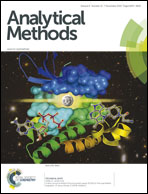Genomodifier capacity assay: a non-cell test using dsDNA molecules to evaluate the genotoxic/genoprotective properties of chemical compounds†
Abstract
We describe here an ultrasensitive and fast protocol called a GEMO assay (genomodifier capacity assay). This non-cell method was developed to identify chemicals with genomodifier (genotoxic and/or genoprotective) capacity. The assay is performed in a black 96-well plate using calf thymus dsDNA exposed to different concentrations of chemicals tested (CT) for 30 minutes with and without the addition of a prooxidant substance that causes dsDNA damage (H2O2, 3 M). Furthermore, PicoGreen®, a highly sensitive dsDNA dye is added and so the fluorescence is emitted according to the concentration of intact dsDNA. Chemicals that cause a break in dsDNA are identified by a decrease in fluorescence in comparison with the fluorescence observed in an untreated dsDNA (control group) indicating genotoxic capacity. In contrast, attenuation of dsDNA degradation caused by H2O2 exposition indicates CT genoprotective capacity. The GEMO assay was validated by comparing peripheral blood mononuclear cells (PBMCs) and an HT29 colorectal cell line exposed to similar conditions where the effect on dsDNA was also evaluated by a DNA alkaline comet assay. Vitamin C was used as CT and other variables were also evaluated to confirm the cytotoxic action of H2O2. The results showed a strong negative correlation between the GEMO assay and the comet assay performed in PBMCs (r2 = −0.828; p < 0.0001) since higher dsDNA fluorescence measured by the GEMO assay was associated with lower index damage measured by the DNA alkaline comet assay. Therefore, the GEMO assay could be useful for early screening of genoprotective and genotoxic effects of chemicals and plant extracts without interfering cell biological variables.


 Please wait while we load your content...
Please wait while we load your content...